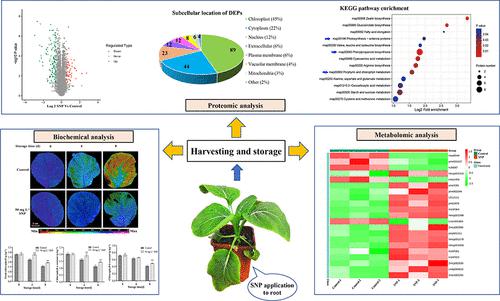当前位置:
X-MOL 学术
›
J. Agric. Food Chem.
›
论文详情
Our official English website, www.x-mol.net, welcomes your
feedback! (Note: you will need to create a separate account there.)
Preharvest Application of Sodium Nitroprusside Alleviates Yellowing of Chinese Flowering Cabbage via Modulating Chlorophyll Metabolism and Suppressing ROS Accumulation
Journal of Agricultural and Food Chemistry ( IF 5.7 ) Pub Date : 2023-06-08 , DOI: 10.1021/acs.jafc.3c00630 Miaomiao Peng 1 , Zhuosheng Chen 1 , Ling Zhang 1 , Yanjing Wang 1 , Shijiang Zhu 1 , Guang Wang 1
Journal of Agricultural and Food Chemistry ( IF 5.7 ) Pub Date : 2023-06-08 , DOI: 10.1021/acs.jafc.3c00630 Miaomiao Peng 1 , Zhuosheng Chen 1 , Ling Zhang 1 , Yanjing Wang 1 , Shijiang Zhu 1 , Guang Wang 1
Affiliation

|
Chinese flowering cabbage is prone to senescence and yellowing after harvest, leading to a huge postharvest loss. Nitric oxide (NO) is a multifunctional plant growth regulator, but the effect of preharvest application of NO on the storage quality of Chinese flowering cabbage remains unclear. Preharvest application of 50 mg L–1 sodium nitroprusside (SNP, a NO donor) to the roots obviously reduced leaf yellowing in Chinese flowering cabbage during storage. Proteomic analysis reveals 198 differentially expressed proteins (DEPs) in SNP-treated plants compared to the control. The main DEPs were significantly enriched in chlorophyll metabolisms, phenylpropanoid synthesis, and antioxidant pathways. SNP treatment enhanced chlorophyll biosynthesis and suppressed chlorophyll-degradation-related proteins and genes. It also modulated flavonoid-biosynthesis-related genes, and 21 significantly regulated flavonoids were identified in SNP-treated plants. The enhanced antioxidant capacity in SNP-treated plants was able to decrease chlorophyll catabolism by inhibiting peroxidase-mediated chlorophyll bleaching. Collectively, preharvest SNP treatment modulated chlorophyll metabolism and preserved chlorophyll content in leaves during storage. Moreover, SNP treatment enhanced flavonoid synthesis, suppressed reactive oxygen species accumulation, and delayed the senescence process, thereby maintaining leaf greening in Chinese flowering cabbage. These findings highlight the role of exogenous NO in alleviating yellowing of leafy vegetables.
中文翻译:

采前施用硝普钠通过调节叶绿素代谢和抑制活性氧积累减轻大白菜黄化
大白菜收获后容易衰老、变黄,导致采后损失巨大。一氧化氮(NO)是一种多功能植物生长调节剂,但采前施用NO对大白菜贮藏品质的影响尚不清楚。收获前施用 50 mg L –1向根部添加硝普钠(SNP,NO供体)可明显减少大白菜贮藏期间叶片黄化。蛋白质组学分析显示,与对照相比,SNP 处理的植物中有 198 个差异表达蛋白 (DEP)。主要 DEP 在叶绿素代谢、苯丙素合成和抗氧化途径中显着富集。SNP 处理增强了叶绿素生物合成并抑制了叶绿素降解相关的蛋白质和基因。它还调节类黄酮生物合成相关基因,并在 SNP 处理的植物中鉴定出 21 种显着调节的类黄酮。SNP 处理植物的抗氧化能力增强,能够通过抑制过氧化物酶介导的叶绿素漂白来减少叶绿素分解代谢。总的来说,采前 SNP 处理调节叶绿素代谢并在储存期间保留叶子中的叶绿素含量。此外,SNP处理增强了黄酮类化合物的合成,抑制了活性氧的积累,延缓了衰老过程,从而保持了大白菜的叶片绿化。这些发现强调了外源一氧化氮在减轻叶类蔬菜泛黄方面的作用。
更新日期:2023-06-08
中文翻译:

采前施用硝普钠通过调节叶绿素代谢和抑制活性氧积累减轻大白菜黄化
大白菜收获后容易衰老、变黄,导致采后损失巨大。一氧化氮(NO)是一种多功能植物生长调节剂,但采前施用NO对大白菜贮藏品质的影响尚不清楚。收获前施用 50 mg L –1向根部添加硝普钠(SNP,NO供体)可明显减少大白菜贮藏期间叶片黄化。蛋白质组学分析显示,与对照相比,SNP 处理的植物中有 198 个差异表达蛋白 (DEP)。主要 DEP 在叶绿素代谢、苯丙素合成和抗氧化途径中显着富集。SNP 处理增强了叶绿素生物合成并抑制了叶绿素降解相关的蛋白质和基因。它还调节类黄酮生物合成相关基因,并在 SNP 处理的植物中鉴定出 21 种显着调节的类黄酮。SNP 处理植物的抗氧化能力增强,能够通过抑制过氧化物酶介导的叶绿素漂白来减少叶绿素分解代谢。总的来说,采前 SNP 处理调节叶绿素代谢并在储存期间保留叶子中的叶绿素含量。此外,SNP处理增强了黄酮类化合物的合成,抑制了活性氧的积累,延缓了衰老过程,从而保持了大白菜的叶片绿化。这些发现强调了外源一氧化氮在减轻叶类蔬菜泛黄方面的作用。











































 京公网安备 11010802027423号
京公网安备 11010802027423号